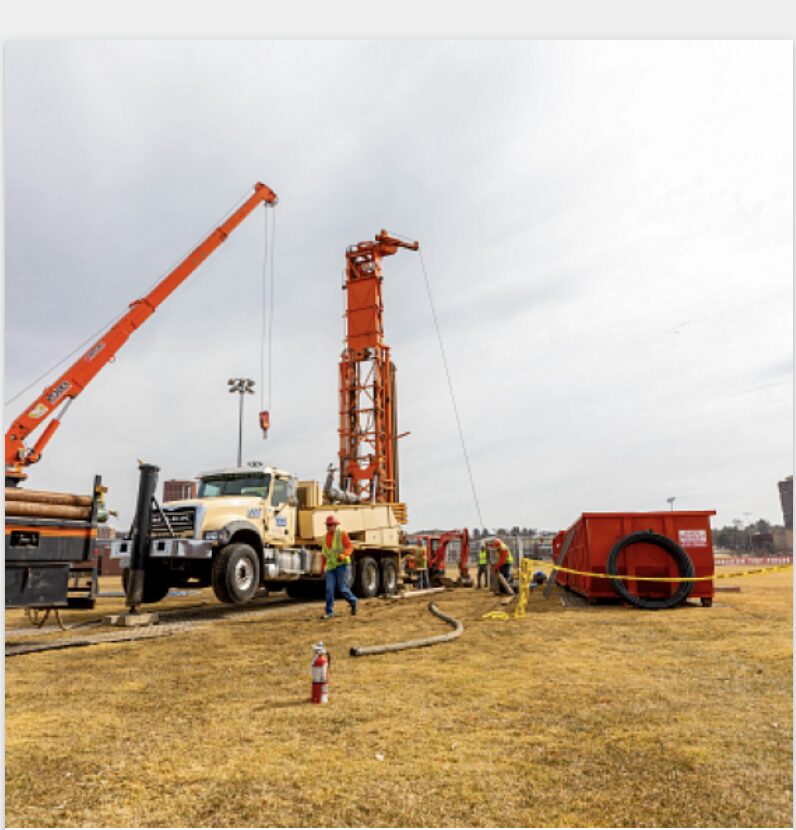Farview Neighbors Raise Concerns About UMass Construction

Photo: umass.edu
Eleven residents of the Farview neighborhood in North Amherst attended an information session presented on October 10 by the UMASS Amherst Office of Community Relations regarding several capital and infrastructural projects that directly impact the neighborhood. Presented by David Dower, Executive Director of Campus Development at UMass Amherst and with input from Tony Maroulis, Executive Director of Community and Strategic Initiatives, Community Relations, and University Events, and Nancy Buffone, Associate Vice-Chancellor of University Relations, the audience was updated on two ongoing construction projects and heard about two slated to begin in the upcoming months: a UMass geothermal project and town streetscape changes.
Located just north of the UMass Amherst rotary, the Farview neighborhood is sandwiched between the two ongoing construction sites — the building addition to the Computer Science Center on Governors Drive and the new School of Public Health and Health Sciences at North Pleasant and University Drive. At the meeting, neighbors shared concerns about the near-constant noise caused by these projects, typically beginning as early as 6:30 am, six days/week.
David Dower also described two streetscape improvement projects scheduled to begin in late winter/early spring. The first will repair damage to the rotary at the north end of UMass Amherst; the second will see repairs to a segment of sidewalk on North Pleasant Street, in front of the Umass School of Education. In addition to some traffic congestion, Farview neighbors can expect further noise from this work. That said, Dower, Maroulis, and Buffone noted that while these streets technically belong to the Town of Amherst, UMass Amherst will cover the cost of repairs.
Large Geothermal Project Coming
The majority of the meeting concerned the large-scale implementation of a geothermal project with the drilling of deep geothermal wells, slated to begin in November, 2024, and continuing until May, 2025, if all goes according to schedule. With the admirable aim of kickstarting UMASS Amherst’s trajectory to become a zero-carbon campus by 2050, this initiative will involve drilling 70 geothermal wells to a depth of 800 feet each and installing a 2.2 million gallon thermal storage tank.
Crucially, the well field will be located under Parking Lot 31 on the north side of Governor’s Drive, across the street from the Manning College of Information and Computer Sciences, and very close to Farview neighborhood homes. One audience member asked why the wellfield is not located further away in Lot 26, which is considerably farther from any residential neighborhood. While Lot 26 is bounded to the west by wetlands, it appears to be sufficiently large to be useable even with the requisite environmental setbacks.
While UMass continues to work towards approval from the Conservation Commission, the geothermal project is moving forward despite a near total absence of input from and involvement by abutting neighbors. Members of the audience voiced other concerns, including the inevitable physical vibrations caused by drilling, noise from the drilling rigs and other machinery, and most significantly, noise caused by drilling five wells at a time into bedrock. Furthermore, although the plan is to keep Governor’s Drive open throughout and narrowing the traffic to one lane when necessary to accommodate heavy equipment, UMass does not appear to have a noise mitigation plan in place. Some also worry about the unknown environmental and infrastructural impacts of the proposed drilling, particularly so close to a residential neighborhood. When asked about these potential risks, the UMass representatives noted that there is reliable evidence for the safety of this technology but did not share environmental impact statements. They cited the fact that Dartmouth and Amherst Colleges are both working on similar geothermal initiatives. However, like UMass, these other campus projects appear to also be in the very earliest stages of development and implementation.
Many community members support clean energy initiatives such as geothermal technology and UMass’ aim of becoming a zero carbon campus by 2050. That said, it is unclear why the well field needs to be located so close to a residential area when other options clearly exist. Moreover, there is a growing discomfort with UMass’ failure to provide plans, environmental impact documents, and concrete data that support the University’s assertion that drilling is without risk, both in the short- and long-term.
